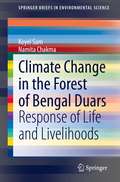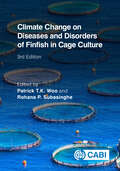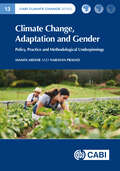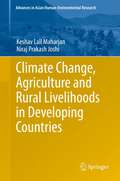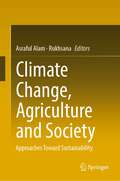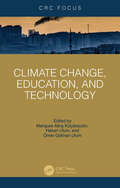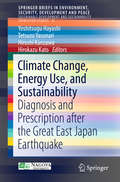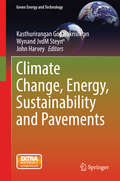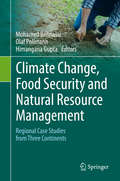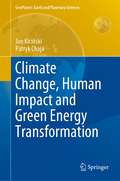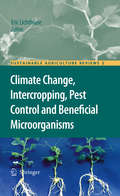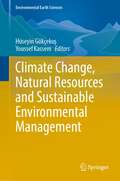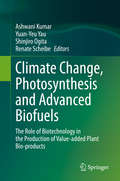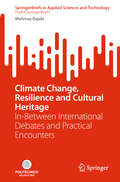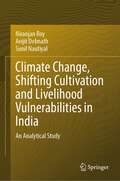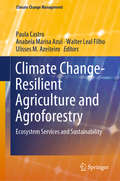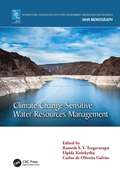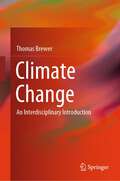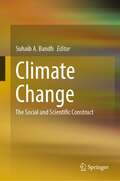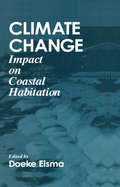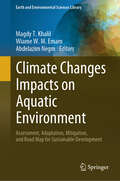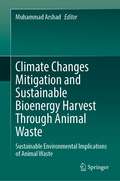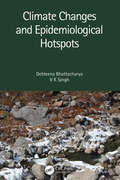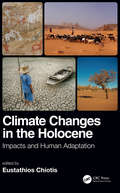- Table View
- List View
Climate Change in the Forest of Bengal Duars: Response of Life and Livelihoods (SpringerBriefs in Environmental Science)
by Koyel Sam Namita ChakmaThis book focuses on more than 100 years of climatic oscillation in Bengal Duars, a unique foothill landscape of the Eastern Himalaya, to discuss the dynamics of life and livelihoods of forest dependent communities towards climate change related impacts. The authors describe the struggles the people of this region face, including climate vulnerability, displacement, migration, and human-animal conflict, and provides a unique and comprehensive analysis of the interconnection between perceptions and responses of forest villagers for survival and adaptation to climate change. The book presents advanced quantitative methods and field-based studies applied in the region to help researchers and policy makers comprehend and measure potential and actual adaptation attitudes of the villagers, while also understanding the present challenges, risk patterns, and potential impacts climate change has on the natural environment and community life. The book will additionally be of interest to students and researchers in geography, forestry, ecology and environmental science.
Climate Change on Diseases and Disorders of Finfish in Cage Culture
by Patrick T.K. Woo Rohana P. SubasingheThis, the third volume in the series Climate Change and Fish Health, describes how finfish in cage culture and their pathogens are directly or indirectly affected by ongoing changes to the environment. These changes, which include a global rise in water temperature with increased acidification and reduction in dissolved oxygen, will continue even if we can significantly reduce the current output of anthropogenic carbon dioxide and methane. The third edition of Diseases and Disorders of Finfish in Cage Culture has been renamed to be included in the series, and is completely updated and revised. It has: · Nine updated chapters with new expert contributions from around the world · A focus on the effects that climate change has, and will have, on finfish and their pathogens · New material includes chapters on algal blooms, biosecurity and fish welfare · An emphasis on practical recommendations and changes that can be made to improve fish health This book is key reading for all involved in cage culture of finfish, research scientists, ecologists, fish health consultants, veterinarians, policy makers and all who are interested in fish health and changes to the environment. It is a good reference text for 'workshops on fish health' and academic courses such as aquaculture and fish health.
Climate Change, Adaptation and Gender: Policy, Practice and Methodological Underpinnings (CABI Climate Change Series #17)
by Dr Mamta Mehar Professor Narayan PrasadThis book offers a wide, in-depth study of the gender-climate change-agriculture nexus. The crux of understanding these connections comprises gender equality and tools to measure gender discrimination, the evolution of the concept of gender inclusiveness and its concerns; and the need to address the same by formulating gender-inclusive policymaking. Despite the fact that more than 50 years have elapsed since gender concerns were included in explorations of this nexus, there is still ambiguity around the foundations, connections, and approaches for planning gender-inclusive climate policies. This book aims to clear that ambiguity by: · Being the first to explore exclusively this issue in detail. · Revealing how and why consideration of gender is so important for understanding how climate change impacts rural communities and agricultural systems globally. · Exploring every dimension of climate change (including belief systems and perceptions, knowledge, experience, coping strategies, adaptation, and mitigation strategies) and linking it to gender. It includes new theoretical and methodological approaches that go far beyond the household as the unit of analysis (using various approaches, including intersectional analysis). The book not only throws light on major themes of research, but also covers different methodologies ranging from review methods to mathematical models, conceptual frameworks and empirical analysis. It will be of wide interest to students, scholars, and researchers in gender studies, agriculture, climate change and rural development research, and also to practitioners, extension workers, and planners designing new climate-resilient practices.
Climate Change, Agriculture and Rural Livelihoods in Developing Countries (Advances in Asian Human-Environmental Research)
by Keshav Lall Maharjan Niraj Prakash JoshiThis book is about climate change and its relation to agriculture and rural livelihoods. It starts by providing a basic understanding of climate change science followed by the relation of climate change to agriculture, the impact of which is discussed based on the particular impact of climate change on plant and animal physiology. The book further discusses the inclusion of the agriculture sector in various international climate change negotiations. It also reviews the cost and opportunities for agricultural projects through international climate change regimes, specifically the Clean Development Mechanism under the Kyoto Protocol. With this background, the book finally proceeds to an explanation of the methodologies used to assess the impact of climate change on agriculture and empirically discusses its impact on agriculture and rural livelihoods in Nepal.
Climate Change, Agriculture and Society: Approaches Toward Sustainability
by Rukhsana Asraful AlamThis book discusses emerging contexts of global warming and climate change, agricultural vulnerability and adaptation from local to global scale. Climate change, resilience in relation to agriculture and livelihoods and multi-dimensionality of various approaches are clearly taken into account by providing studies and perspectives on various methods and scales based on natural science to social science frameworks. This edited work contains chapters that are interdisciplinary, covering climate change, agriculture vulnerability, disaster impact, productivity efficiency, food security, livelihood resilience, land degradation, sustainability, in terms of plan and perform for transformation, sustainability and adaptation, including philosophy, change and economics, as well as the natural sciences. This book addresses the sustainable development goals to reduce the adverse impacts on agricultural productivity brought on by climate change and its adaptation and disaster risk reduction in developing and developed nations. Some of the assessed challenges include soil erosion, land use conversion, natural resource mismanagement, crop productivity decline and economic stagnation. This book covers important issues in the production and consumption of food in the past and present periods, agriculture, livelihood, and climate change, disaster risk management and society. All of these are under the threat of ongoing climate change and significant challenges to livelihood sustainability. The book is arranged into five broad sections: each part will cover a set of chapters dealing with a particular issue of the climate change, agriculture and society: approach toward sustainability. This book aims to attract attention of students, researchers, academician, policymakers and other inquisitive readers interested in different aspects of climate change, agriculture, livelihood and sustainability, particularly at local to global context.
Climate Change, Education, and Technology
by Ömer Gökhan Ulum Hakan Ulum Menşure Alkış KüçükaydınThe climate change crisis is the greatest challenge humanity has ever confronted. As human activities are the most significant cause for this crisis, the solution must come from within humanity. While global movements—NGOs, universities, municipal governments, etc.—are doing their part to combat the crisis, the role of education and technology cannot be emphasized enough. Education is necessary to enhance awareness, especially among the youth, generate solutions, and implement them. Technology contributes to this process by creating climate change-fighting solutions, accumulating and analysing data, and providing energy efficiency. Technology also enables the monitoring of the climate, the mitigation of its effects, and the enhancement of the environment. Therefore, climate change, education, and the use of technology should be addressed as a unit. In this volume, the authors integrate climate change, education, and technological applications.This book is comprehensive and offers readers a variety of perspectives, encouraging the generation of novel and inventive ideas. The collaboration of authors from various disciplines to address the issue brings about novel and intriguing perspectives.
Climate Change, Energy Use, and Sustainability: Diagnosis and Prescription after the Great East Japan Earthquake (SpringerBriefs in Environment, Security, Development and Peace #25)
by Yoshitsugu Hayashi Tetsuzo Yasunari Hiroshi Kanzawa Hirokazu KatoThis book is an outcome of the symposium "Towards Earth Friendly Use of Resources and Energy," organized by the Nagoya University Center of Excellence Program "From Earth System Science to Basic and Clinical Environmental Studies" and presents papers by four eminent researchers. 1) Syukuro Manabe, who was honored in 2008 by the Earth Hall of Fame Kyoto, together with Ms. Maathai and Ms. Brundtland, describes the mechanisms of extreme weather, drought, and flood that were caused by climate change due to CO2 emissions. 2) Ernst Ulrich von Weizsäcker, co-chair of the Club of Rome, describes "Factor 4 and 5" concepts such as technological progress and redesigning socioeconomic systems, e. g. taxation, and stresses the importance of humanity. 3) Hans-Peter Dürr, ex-president of the Max Planck Physics Institute as a successor of Heisenberg, explains the mechanism of a living Earth sustained by accumulated energy resources provided by the sun. He clarifies a point on preserving the dynamic stability of minerals and life on Earth. 4) Shohei Yonemoto, a well-known political scientist focusing on sustainability, explains environmental politics and why the IPCC and UNFCCC framework were established based on precaution principles. He puts forward a new concept called futurology, which considers population and food problems from a Malthusian standpoint and incorporates them into issues such as climate change and natural disasters. This book is written and based on a very simple but concrete idea and provides the readers with a chance to consider the shape of future Earth.
Climate Change, Energy, Sustainability and Pavements (Green Energy and Technology)
by John Harvey Kasthurirangan Gopalakrishnan Wynand Jvdm SteynClimate change, energy production and consumption, and the need to improve the sustainability of all aspects of human activity are key inter-related issues for which solutions must be found and implemented quickly and efficiently. To be successfully implemented, solutions must recognize the rapidly changing socio-techno-political environment and multi-dimensional constraints presented by today's interconnected world. As part of this global effort, considerations of climate change impacts, energy demands, and incorporation of sustainability concepts have increasing importance in the design, construction, and maintenance of highway and airport pavement systems. To prepare the human capacity to develop and implement these solutions, many educators, policy-makers and practitioners have stressed the paramount importance of formally incorporating sustainability concepts in the civil engineering curriculum to educate and train future civil engineers well-equipped to address our current and future sustainability challenges. This book will prove a valuable resource in the hands of researchers, educators and future engineering leaders, most of whom will be working in multidisciplinary environments to address a host of next-generation sustainable transportation infrastructure challenges. "This book proposes a broad detailed overview of the actual scientific knowledge about pavements linked to climate change, energy and sustainability at the international level in an original multidimensional/multi-effects way. By the end, the reader will be aware of the whole global issues to care about for various pavement technical features around the world, among which the implications of modelling including data collection, challenging resources saving and infrastructures services optimisation. This is a complete and varied work, rare in the domain. " Dr. Agnes Jullien Research Director Director of Environmental, Development, Safety and Eco-Design Laboratory (EASE) Department of Development, Mobility and Environment Ifsttar Centre de Nantes Cedex- France "An excellent compilation of latest developments in the field of sustainable pavements. The chapter topics have been carefully chosen and are very well-organized with the intention of equipping the reader with the state-of-the-art knowledge on all aspects of pavement sustainability. Topics covered include pavement Life Cycle Analysis (LCA), pervious pavements, cool pavements, photocatalytic pavements, energy harvesting pavements, etc. which will all be of significant interest to students, researchers, and practitioners of pavement engineering. This book will no doubt serve as an excellent reference on the topic of sustainable pavements. " Dr. Wei-Hsing Huang Editor-in-Chief of International Journal of Pavement Research and Technology (IJPRT) and Professor of Civil Engineering National Central University Taiwan
Climate Change, Food Security and Natural Resource Management: Regional Case Studies from Three Continents
by Mohamed Behnassi Olaf Pollmann Himangana GuptaThis book contributes to the on-going debates on climate change by focusing on the SDGs and exploring linkages between environmental change and food security as well as the relevance and need to consider the management of natural resources, especially water, soil and forest. Compared to relevant existing publications, this book covers case studies that capture the everyday realities of the local people and how they react and adapt to similar situations in different geographical settings. Each case study presented in this book gives a particular message. The strength of this book lies in the fact that it covers the most neglected topics in climate negotiations in spite of the fact that these decide the fate of millions of people around the world, especially the developing countries. By presenting a collection of case studies from Africa, Asia and Europe, this book encourages cross-continental knowledge sharing. The scope of the book ranges from impacts to mitigation and from in-field experiments to policy implementation. It contributes to the existing knowledge on climate-food nexus and connects climate change to sectors it could impact directly. All chapters in this book emphasise local ownership of strategy processes, effective participation from all levels, and high-level commitment. Besides being relevant for the academicians and scholars working in the field of climate change, forest and agriculture, it aims to catch interest of the policy makers and practitioners to understand ground realities for appropriate action. It is also bound to make an impact on the Non-Governmental Organizations around the world and in the three different continents that this book covers, considering the indigenous and local issues highlighted in this book.
Climate Change, Human Impact and Green Energy Transformation (GeoPlanet: Earth and Planetary Sciences)
by Jan Kiciński Patryk ChajaThis book indicates the most optimal solutions for the growing civilization problem related to climate change that takes place more and more rapidly on our planet. It is divided into two parts: In the first part, the authors - based on the available analyses and reports on climate change taking place on Earth - present their own point of view in relation to the above issue, while trying to find answers to the following questions: · Why is it so difficult to admit that humans are responsible for the ongoing climate change? · Will climate change destroy life on Earth? · Can science and modern technologies stop this process? In the second part of the book, the authors propose a solution for the advancing climate change, regarding the reduction of CO2 emissions coming mainly from the energy sector. On the basis of scientific achievements and implementations of research institutions in Poland, especially the Institute of Fluid-Flow Machinery of the Polish Academy of Sciences in Gdansk, the book proposes directions of development of the energy transformation in Poland and other countries for which fossil fuels currently make a large contribution to the energy production process and are the main emitter of CO2 to the atmosphere. The book is addressed to citizens, ecologists, climatologists as well as politicians and experts responsible for shaping the climate and energy policy of the country level and also the world.
Climate Change, Intercropping, Pest Control and Beneficial Microorganisms (Sustainable Agriculture Reviews #2)
by Eric LichtfouseSustainable agriculture is a rapidly growing field aiming at producing food and energy in a sustainable way for humans and their children. Sustainable agriculture is a discipline that addresses current issues such as climate change, increasing food and fuel prices, poor-nation starvation, rich-nation obesity, water pollution, soil erosion, fertility loss, pest control, and biodiversity depletion. Novel, environmentally-friendly solutions are proposed based on integrated knowledge from sciences as diverse as agronomy, soil science, molecular biology, chemistry, toxicology, ecology, economy, and social sciences. Indeed, sustainable agriculture decipher mechanisms of processes that occur from the molecular level to the farming system to the global level at time scales ranging from seconds to centuries. For that, scientists use the system approach that involves studying components and interactions of a whole system to address scientific, economic and social issues. In that respect, sustainable agriculture is not a classical, narrow science. Instead of solving problems using the classical painkiller approach that treats only negative impacts, sustainable agriculture treats problem sources. Because most actual society issues are now intertwined, global, and fast-developing, sustainable agriculture will bring solutions to build a safer world. This book series gathers review articles that analyze current agricultural issues and knowledge, then propose alternative solutions. It will therefore help all scientists, decision-makers, professors, farmers and politicians who wish to build a safe agriculture, energy and food system for future generations.
Climate Change, Natural Resources and Sustainable Environmental Management (Environmental Earth Sciences)
by Hüseyin Gökçekuş Youssef KassemThis book is a compilation of selected papers from the Fifth International Conference on Natural Resources and Sustainable Environmental Management held in Near East University, November 2021. It provides intellectual guidance and scientific evidence on the challenges of global warming and climate change based on a humanistic and critical thinking approach, promoting research and education to build equality in the global community and more sustainable societies. This book also addresses the current challenges of bridging the gap between government policymakers and providers of science and solutions with innovative ideas and new visions to help resolve the challenges facing us in the area of natural resources (water, energy), and environment.
Climate Change, Photosynthesis and Advanced Biofuels: The Role of Biotechnology in the Production of Value-added Plant Bio-products
by Ashwani Kumar Shinjiro Ogita Yuan-Yeu Yau Renate ScheibeThe use of fossil fuels results in rising CO2 and other greenhouse gas (GHG) emissions, causing global temperature rise and climate change that will negatively impact human health, the food supply, and eventually worsen hunger and misery. Presently, fossil fuels meet 88% of the energy demand, resulting in rising CO2/GHG emissions at alarming rates. The increased use of biofuels would help to mitigate climate change. Efficiently designing methods for the production of biofuels and plant-derived high-value products requires a deeper understanding of photosynthetic processes as a prerequisite for applying novel biotechnologies. Accordingly, this book provides ample information and a wealth of illustrative examples. The book’s eighteen richly illustrated chapters are divided into three thematic parts. I: Photosynthesis and Biomass Production under Changing Conditions, II: Microalgae and Engineered Crops for Production of Biofuels and High-value Products, and III: Genetic Resources and Engineering Methods to Improve Crop Plants. Readers will find the latest information on the molecular basis of photosynthetic processes in plants (including the regulatory principles that allow plants to maintain homeostasis under changing conditions), stress resistance and synthetic pathways. In addition, the basic principles of important biotechnologies, as well as examples of specially designed crops capable of growing under stress conditions with improved productivity, are presented. The book sets the course for future research in the field of biofuel development and production and provides both general and specific information for students, teachers, academic researchers, industrial teams, and general readers who are interested in new developments concerning the production of biofuels with value-added properties.
Climate Change, Resilience and Cultural Heritage: In-Between International Debates and Practical Encounters (SpringerBriefs in Applied Sciences and Technology)
by Mehrnaz RajabiThis book showcases the cross-disciplinary and “systemic” relationships among climate change, resilience, and cultural heritage. It critically reviews the contemporary international documents and scholarly debates of the climate science, disaster risk management, and heritage fields and reveals that, within the comprehensive point of view, the potential and advances in one field could be instrumentalized in other fields. Moreover, it provides tailor-made considerations and practical recommendatory encounters toward resilient cultural heritage in facing climate change as a “disaster risk driver”. Lastly, the book highlights the significance of the cultural dimension of climate change as well as the global landscape of systemic risk while redefining a new comprehensive and holistic definition of resilience for the heritage field.
Climate Change, Shifting Cultivation and Livelihood Vulnerabilities in India: An Analytical Study
by Sunil Nautiyal Niranjan Roy Avijit DebnathThis book explores how climate change affects households that rely on shifting cultivation and how to assess their vulnerability. This study looks at micro and macro levels in Indian states with indigenous communities practicing shifting cultivation. The micro-level study has been conducted in 52 villages, with 1469 households covering 7067 population in seven states of India in the Northeastern region. The book covers different topics related to climate change, such as its patterns, impact on households and agriculture, forest management, and the role of indigenous knowledge in mitigation. This research is associated with different sectors like shifting agriculture, forestry sector, climate change and rural development etc. and integrated with large respondents and stakeholders through both direct and focus group discussions. Research scholars, climate activists, institutional and non-institutional organisations, people interested in environmental science, social science and policymakers will find this book very relevant.
Climate Change-Resilient Agriculture and Agroforestry: Ecosystem Services and Sustainability (Climate Change Management)
by Walter Leal Filho Ulisses M. Azeiteiro Paula Castro Anabela Marisa AzulThis book collects wide-ranging contributions such as case studies, reviews, reports on technological developments, outputs of research/studies, and examples of successful projects, presenting current knowledge and raising awareness to help the agriculture and forestry sectors find solutions for mitigating climate variability and adapting to change. It brings the topic of ecosystem services closer to education and learning, as targeted by the Framework Convention on Climate Change and the Paris Agreement, the 2030 Agenda for Sustainable Development and the EU Biodiversity Strategy to 2020. Climate change and its impacts on agriculture and agroforestry have been observed across the world during the last 50 years. Increasing temperatures, droughts, biotic stresses and the impacts of extreme events have continuously decreased agroforestry systems’ resilience to the effects of climate change. As such, there is a need to adapt farming and agroforestry systems so as to make them better able to handle ever-changing climate conditions, and to preserve habitats and ecosystems services.
Climate Change-Sensitive Water Resources Management (IAHR Monographs)
by Ramesh S. V. Teegavarapu Elpida Kolokytha Carlos de Oliveira GalvãoThe book provides an overview of climate change-sensitive water resources management with consideration of adaptation approaches, the assessment of climate change impacts, current contemporary management techniques, and ecological responses. Comprehensive assessments and studies from eight countries using innovative approaches that aid water management under evolving climates are documented. Topics ranging from hydrologic design to management and policy responses to climate change are discussed, which demonstrate updated theories that highlight methods, tools, and experiences on the topic of water resources under climate change. The generic approaches discussed, and their applications to different climate change-related problems, make this book appealing to a global readership. The practical and applied methodologies presented in the book and through insightful case studies discussed will provide readers worldwide with ready-to-use information to manage water resources sustainably under evolving climate. This book is ideally suited for water resource managers, scientists, professionals from water management agencies, graduate students, and national laboratory agencies responsible for water and environmental management.
Climate Change: An Interdisciplinary Introduction
by Thomas BrewerThis textbook introduces and explains the issues around climate change and its mitigation. It includes topics across disciplines and can be used as a single-volume text by students studying a range of subjects. Among the topics included are: ·How to adopt significant mitigation measures now to avoid the most catastrophic long-term consequences of climate change.·Reducing the rates of highly potent, short-lived emissions of methane gas and black carbon particulates—reductions that are necessary to meet the temperature targets of the Paris Agreements.·Implementing wide-ranging adaptation measures to reduce the deaths and economic costs of extreme heat waves, droughts, wildfires, hurricanes, and floods.·Recognizing the unusually rapid warming in the Arctic, which is disrupting weather patterns in the northern hemisphere and currents in the Atlantic Ocean, causing world-wide sea-level rise, and also causing methane leaks in the Arctic region—leaks that could eventually lead to irreversible global warming consequences. Meeting these challenges effectively requires action by both governments and businesses. The book examines the national and local governmental policies—and business practices—that are needed in sector-specific chapters. An objective of the book is to inform readers about specific problems resulting from climate change—and the wide range of potential government policies and business practices, changes in technologies, and changes in public attitudes and actions that can reduce the emissions and otherwise lessen their impacts. Indeed, a central message is that understanding the issues posed by climate change requires no less than an understanding of climate science, micro- and macro-economics, technologies for mitigation and adaptation measures, as well as politics and law at many governmental levels from local to global. The author has included short case studies that illustrate and integrate multiple analytic perspectives. The book is therefore appropriate for students, professionals, and general audiences with wide-ranging interests and backgrounds.
Climate Change: The Social and Scientific Construct
by Suhaib A. BandhBeginning in the second half of the twentieth century, the impacts of climate change have been fierce, causing loss of human life and irreparable destruction to natural and man-made infrastructure in many parts of the world.The difference between climate change now and in the past is that of sudden and disproportionate disruption of the natural energy dynamics by the changing consumption patterns of billions of human beings who have polluted terrestrial and aquatic ecosystems. The picture that emerges from the exhaustive analysis of international data drawn from the most reliable sources indicates that we have possibly gained access to the gateway of extinction and it is time that we take corrective steps immediately.Global climate change is further altering our relationship with the environment, modifying relatively stable climatic factors and making them uncertain, unpredictable, and threatening. Changes in land use and an increasing demand for water resources due to climate change have affected the capacity of ecosystems to sustain food production, ensure the supply of freshwater resources, provide ecosystem services, and promote rural multi-functionality. Ensuring food production does not just depend on increasing water efficiency, promoting climate resilient crop production, or reducing land-use competition for urbanization but also on a more suitable and stable climate as the changes in climatic factors like precipitation, temperature, radiation, evaporation, and wind bring about some major shifts in global food supplies. According to Special Report on Emission Scenarios (SRES), focused on greenhouse gas emissions projections, and Representative Concentration Pathways (RCPs) conducted by the Intergovernmental Panel on Climate Change (IPCC), climate change increases the risk of simultaneous crop failures (including corn, rice, legumes, and vegetables) if irrigation systems are not fully adapted to water stress situations. A changing climate could have many adverse impacts on other sectors of our environment. This book offers concrete, up-to-date, and appropriate study cum research material for students, researchers, academicians and policymakers. It will be of a greater interest to students and researchers in the field of environmental science, agriculture science, agronomy, and sustainable development.
Climate Change: A Wicked Problem
by Frank P. IncroperaUnder one cover, Frank P. Incropera provides a comprehensive, objective and critical assessment of all issues germane to the climate change debate: science, technology options, economic ramifications, cultural and behavioural issues, the influence of special interests and public policy, geopolitics and ethical dimensions. The underlying science is treated in depth, but in an approachable and accessible manner. A strong case is made for the reality of anthropogenic climate change, while confronting the range of issues that remain uncertain and deconstructing opposing views. Incropera assesses the strengths and weaknesses of technology options for mitigating the effects of climate change, analyzes nontechnical factors - economic, cultural and political - and provides an in-depth treatment of ethical implications. This book is intended for those wishing to become fully informed about climate change and is designed to provide the reader with a firm foundation for drawing his or her own conclusions.
Climate ChangeImpact on Coastal Habitation
by Doeke EismaTemperature and precipitation increase and decrease because of natural causes. However, anthropogenic changes, such as an enhanced greenhouse effect, may result in alterations in the regional climate and in relative sea level. Serious changes in climate and sea level-with adverse effects particularly along low-lying coasts-would affect millions of people. Climate Change takes an in-depth, worldwide look at coastal habitation with respect to these natural and anthropogenic changes.No universally applicable coastal model can be used to describe climatic changes. This unique book provides individual discussions of beaches and barrier islands, cliffs, deltas, tidal flats and wetlands, reefs, and atolls. The impact of climatic change on coastal ecology and agriculture is investigated, and human responses to the effects of climatic change along the world's coasts are included.
Climate Changes Impacts on Aquatic Environment: Assessment, Adaptation, Mitigation, and Road Map for Sustainable Development (Earth and Environmental Sciences Library)
by Abdelazim Negm Magdy T. Khalil Wiame W. M. EmamThis book provides a detailed and a clear picture about the impact of climate changes on all aspects of our lives. The book will shed some lights on the challenges and obstacles that agricultural development in different countries are going through regarding the dimensions of food security due to climate change. The vulnerability of agricultural system will be discussed and the methods to adapt to some impacts of climate change will be projected. Some authors will focus on how Global Climate change may directly or indirectly affect the water cycle and, consequently, the quantity and quality of water resources needed to meet human and environmental demands. It can lead to recurrent floods and droughts, rising sea water levels with serious effect on coastal aquifers, and extreme water temperatures that can exacerbate many forms of water pollution. Water supply reliability, health, agriculture, energy, biodiversity and aquatic ecosystems will all suffer the impact of such challenges.The demand for water to meet these needs is also affected by climate change. Evidently, adopting a holistic water-energy-food nexus approach, while promoting the use of non-conventional water resources, can better support a transition to sustainability, a fact that should appeal to national interest and encourage governments, the private sector and civil society to engage. The results of the Climate changes conference; COP 27 that held in Sharm El-Sheikh in 2022, will be discussed in some chapters to illustrate the several efforts that have been taken by some countries to adapt to climate changes, including continuous breeding program to produce crops adapted to higher temperature, salinity, shorter in life cycle, and better in post-harvest and shelf life. The efforts to improve on farm water management and reduce water consumption in agriculture to increase water productivity will be discussed. Saving water from agriculture will be associated with saving fertilizers to control GHG emissions and could allow allocating water for land reclamation. Some Chapters aim at highlighting the impact of climate change on water resources depending on a clear understanding of how climate, fresh water, and biophysical and socio-economic systems are interconnected at the global and regional scales, meanwhile presenting state-of-the-art technologies and innovative/holistic solutions for adaptation and mitigation measures, and increasing the resilience of vulnerable communities to climate change, with the ultimate goal of achieving sustainable development towards “the future we want” while “leaving no one behind.
Climate Changes Mitigation and Sustainable Bioenergy Harvest Through Animal Waste: Sustainable Environmental Implications of Animal Waste
by Muhammad ArshadThe valuable characteristics of animal waste materials in terms of climatic change impact and bioenergy production are discussed in this book. Reutilization of such wastes for bioenergy harvest is the prime focus; the great need for future animal waste recycling is also depicted.Major topics discussed are types of livestock waste – poultry and dairy, methods and management of waste utilization and storage, application of animal waste in bioenergy production, economics of waste utilization, novel disposable techniques, circular bioeconomy, pollution, and water quality. Furthermore, utilization of animal waste for resource conservation and environmental protection is discussed, such as potential materials for green biochemicals. Resource recovery can, therefore, forestall the shortage of natural resources and, at the same time, can greatly reduce waste-disposal problems and energy crises. Many alternatives to waste disposal, either currently available or under study, focus on the recovery of material or energy. In a world of diminishing resources and increasing needs, each opportunity for the recycling of animal waste materials has been examined.This book significantly contributes toward climate change mitigation through better environmental solutions. A better understanding of animal waste recycling to mitigate climate changes has been portrayed in order to generate discussions among researchers and administrators. Environmental implications of animal waste are of prime importance in climate change scenario. Such wastes also harbor zoonotic pathogens that are transported in the environment.Finally, it has been tried out to collect ideas and experience in multiple aspects of animal waste management for climate change mitigation and bioenergy harvest.
Climate Changes and Epidemiological Hotspots
by V K Singh Debleena BhattacharyaClimatic change plays an integral part in planetary health and is amongst the most important global environmental aspect that has an impact on human health. The linkage between the environmental change and disease dynamics has been highlighted in recent times and hence, emphasis on environmental sustainability to reduce future epidemics. Present book focusses on the relationship between climatic change and epidemiological factors with an approach to reduce the global hotspots. The climatic changes relevant to periods of activity and variations in geographical distribution is addressed including interconnection of sustainability, population growth and environmental change. Features: Covers environmental management and waste to resource for future. Includes guidelines for analysis, assessment, and interventions for waste management. Discusses environmental impediments in the way of healthcare inclusions. Impresses upon the importance of clinical epidemiology to detect, treat, control, and prevent the spread of non-communicable diseases globally. Provides insights for the future health hazards that can be administered at the insignificant stage. This book aims at Graduate Students, Researchers, Professionals and Health Care Professionals in environmental engineering, waste management, climate change, and healthcare.
Climate Changes in the Holocene: Impacts and Human Adaptation
by Eustathios ChiotisThis book highlights climate as a complex physical, chemical, biological, and geological system, in perpetual change, under astronomical, predominantly, solar control. It has been shaped to some degree through the past glaciation cycles repeated in the last three million years. The Holocene, the current interglacial epoch which started ca. 11,700 years ago, marks the transition from the Stone Age to the unprecedented cultural evolution of our civilization. Significant climate changes have been recorded in natural archives during the Holocene, including the rapid waning of ice sheets, millennial shifting of the monsoonal fringe in the northern hemisphere, and abrupt centennial events. A typical case of severe environmental change is the greening of Sahara in the Early Holocene and the gradual desertification again since the fifth millennium before present. Climate Changes in the Holocene: Impact, Adaptation, and Resilience investigates the impact of natural climate changes on humans and civilization through case studies from various places, periods, and climates. Earth and human society are approached as a complex system, thereby emphasizing the necessity to improve adaptive capacity in view of the anthropogenic global warming and ecosystem degradation. Features: Written by distinguished experts, the book presents the fundamentals of the climate system, the unparalleled progress achieved in the last decade in the fields of intensified research for improved understanding of the carbon cycle, climate components, and their interaction. Presents the application of paleoclimatology and modeling in climate reconstruction. Examines the new era of satellite-based climate monitoring and the prospects of reduced carbon dioxide emissions.
